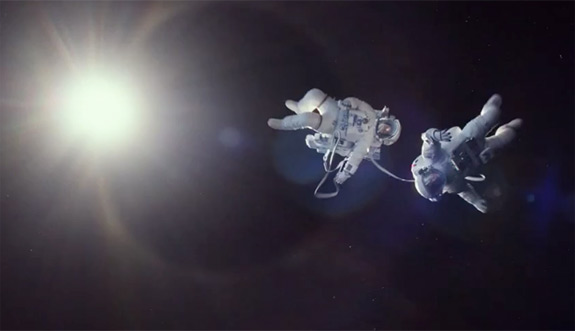

MPAA Rating, PG-13
USCCB Rating, A-III
Reel Rating: ![]()
![]()
![]()
![]()
![]() (5 Reels out of 5)
(5 Reels out of 5)
[Editor’s note: Alert! Spoilers ahead!]
Space is empty, void of matter, energy, heat, and any chance of survival for the smallest bacteria, much less a human being. It is a testament to human ingenuity that, since 1961, explorers have been entering and even living in this vast and silent wasteland. Director Alfonso Cuarón’s Gravity is a soaring witness to these feats, an excellent thriller that revels in the ferocity of nature, the power of prayer, and the triumph of man as image of the Creator. In an Icarian age, Gravity is an important reminder that despite centuries of technology, all are still in the hands of God, and that is a good thing they are the hands of a loving Father.
In classic Cuarón style, the first fifteen minutes of Gravity is a single, uninterrupted take that weaves seamlessly between engineer Dr. Ryan Stone (Sandra Bullock) and NASA astronaut Matt Kowalski (George Clooney) as they repair the Hubble telescope 600km above the surface of the Earth. It’s a breathtaking sequence that rivals any in cinematic history as the audience sees the immensity of the planet and outer space juxtaposed with close-ups of the scientists chatting casually like car mechanics.
This is Stone’s first trip, and she is nervous and undisciplined. Kowalski is just hours from breaking the record for spacewalk duration and moves around easily, as if he was trimming his own backyard. Suddenly, debris from a satellite crash rips through their shuttle leaving them stranded in space. It is violent and terrifying, especially since it happens without any sound save for the heightened pace of Stone gasping for air and the nerve-racking radio communications between her and Kowalski.
Miraculously, the two survive, but their shuttle is destroyed. They must maneuver over to the International Space Station’s damaged escape pod, not to escape but use it to reach the Chinese station, which does have a functional return capsule. En route, Kowalski encourages Stone talk to him about her life on Earth; she reveals had a daughter who died in a playground accident. Upon reaching the ISS, Kowalski sacrifices himself to give Stone a chance to live. Alone in a foreign world with little knowledge, Stone must survive the returning orbital debris, drive the escape pod to the other station, and finally operate the return capsule (in Chinese) to return home.
Thinking she has failed, Stone begins to cry, making small tear droplets that float in her tiny vessel. She tries to pray but admits that no one ever taught her how. The film critic Stephen Greydanus notes how people in disaster movies never seem to pray even when their lives are close to ending. Stone’s frustrated desire to pray is not only accurate to human nature but a sad reflection on how an agnostic society has failed her. Desperate and overwhelmed, she decides to kill herself by turning off the oxygen.
At this moment, Cuarón steers the film in a new direction. Stone has a vision where Kowalski visits and tells her how to operate the pod. Whether this is the last firings of a dying brain or a visitation from a new saint is unclear. Then again, couldn’t it be both? The experience gives Stone the courage to continue but also to pray. She asks Kowalski to tell her daughter that she loves her and asks them to pray for her safe return. There’s also a short insert of a St. Christopher icon taped to the inside of the pod by the Russians. Not only is God present, so are the saints.
Cuarón is the master of big and small, showing the awe of the universe amid the tiny pleas of miniscule humans, without losing respect for either. The Sun, Earth, and endless space form the constant background of this film, filling the screen. This is a rare movie that is worth the price of IMAX 3D. It is fitting that Gravity was released on the Feast of St. Francis because it is a loving ode to the awe of creation and the God that fastened it. Creation is beautiful because it was made by God but it can also be vicious and unpredictable because it is tainted by original sin.
In the beginning of the film, Kowlaski is amazed by the view while Stone simply works on her software repair. He tells her to “enjoy the ride.” By the end of the film, Stone has accepted this grace. At any moment any person could have the unfortunate fate of Stone’s daughter. As dangerous as space seems, it is little different than the vulnerability of living on solid ground. Having a full existence requires following Christ’s advice to “not worry about your life.”
The last line of the film has a character utter that all-important theological phase: “Thank you.” Amidst the enormity of creation and the microcosm of individual human lives, all one can feel is awe and gratitude. This is the true spiritual gift called “the fear of the Lord.” Nature could simply wipe all life away in the instant, and yet God saves, time and time again. A true theology of creation propels men to worship God, give thanks, and live lives of great joy.
As St. Francis said in his Canticle of the Sun, “Praise and bless my Lord, and give thanks, and serve Him with great humility.”
If you value the news and views Catholic World Report provides, please consider donating to support our efforts. Your contribution will help us continue to make CWR available to all readers worldwide for free, without a subscription. Thank you for your generosity!
Click here for more information on donating to CWR. Click here to sign up for our newsletter.


